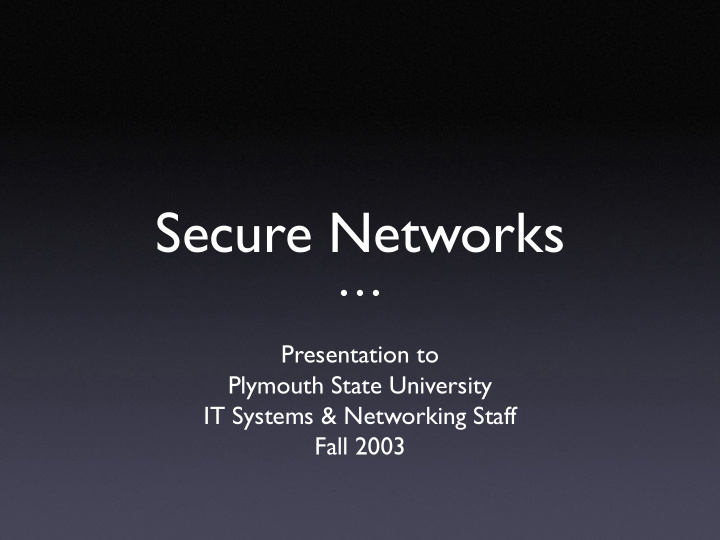



Secure Networks • • • Presentation to Plymouth State University IT Systems & Networking Staff Fall 2003
Security By Isolation • • •
Our Network Servers Internet Public Fac/Staff Firewall Wireless ResNET
Border Security Servers Internet Public Fac/Staff Firewall Wireless ResNET
Interior Anarchy Servers Internet Public Fac/Staff Firewall Wireless ResNET
One Big Pool Servers Internet Public Fac/Staff Firewall Wireless ResNET
Isolate Groups In Their Own Pools Servers Internet Public Fac/Staff Firewall Wireless ResNET
Isolated. Fac/Staff Private Servers Public Outside World ResNET Wireless Public Servers
Networked, But Isolated • Group computers according to users and their activities • Aggressive firewalling as appropriate by group • Limit access to networks by group association • Also to consider: NAT and NoCatAuth
Policy Based Networking • Update our old ideas of ‘private’ and ‘public’ networks • Make the logical structure of our network match our access and security policy • Develop mechanisms to support and enforce this policy
Network Vulnerabilities • • •
Attack Vectors • Attacks originating outside our network • Attacks originating from within our network on targets here or elsewhere • Man-in-the-middle; interception (sniffing) and manipulation of data en-route
Attack Profiles • The Vandal • Denial of service, random damage, data loss • The Brigand • Uses our resources in support of greater crimes • The Thief • Data theft or manipulation
From Whom Are We Vulnerable? • We fear miscreants and hackers ...but... • Every user, authorized and unauthorized, is a potential threat • Threats from ‘authorized’ users, while perhaps less likely, are more directed
Who Are We Trying to Serve? • Thousands • About 7,000 Faculty, Staff and Students now have computer accounts and privileges here Do we trust every one of them?
So... • Any decisions about network security must be made with the recognition that we have a huge number of un-trusted users.
WEP • • •
WEP Vulnerabilities • WEP is shared encryption... • No matter how you distribute it or how often you change the key, all ‘authorized’ WEP users can see and sniff all other WEP ‘encrypted’ traffic
WEP Vulnerabilities • ...And you don’t even have to crack it... • WEP encrypted traffic is sent with IP information in the clear Packets can be intercepted, re-addressed, and re-sent through the AP to a host on the wired network The AP does the decryption, allowing even unauthorized users to easily sniff traffic
Is There An 802.11 Standard That Works? • There is lots of activity to find a real solution to WEP’s failures, but... • Interoperability is two to three years away
What Can We Do Now? • First, we must recognize that many of the risks of wireless also exist on our wired network • And, yes, wireless will always be less secure than wired communications • With that in mind, let’s figure out how to secure our entire network
Reading Room • Wireless Hacks by Rob Flickenger O’Reilly Press, 2003 • Network Magazine CMP United Business Media Remember to be conscious of context Most of the work and reporting is directed to corporate users
Solutions • • •
Similar Service Models • Because of the number and types of customers we serve, we’re more like a public service, a utility, an ISP • We should look to WISPs — wireless internet service providers — for solutions
The WISP Model • Low minimum requirements for client software and hardware — 802.11b wireless with recent browser • Use ‘clientless’ authentication — enter credentials in secure web page • Depend on application layer security, warn customers to do the same • Is secure enough to prevent abuse and theft of service
What Is NoCatAuth? • An open-source captive portal for network authentication and client management. • Integrates DHCP , firewall, and authentication services. • Uses web browser interface to take credentials, changes firewall behavior based on authentication. Looks for and reports ARP spoofing. • Free for client and server; requires no additional client configuration.
Recommend
More recommend